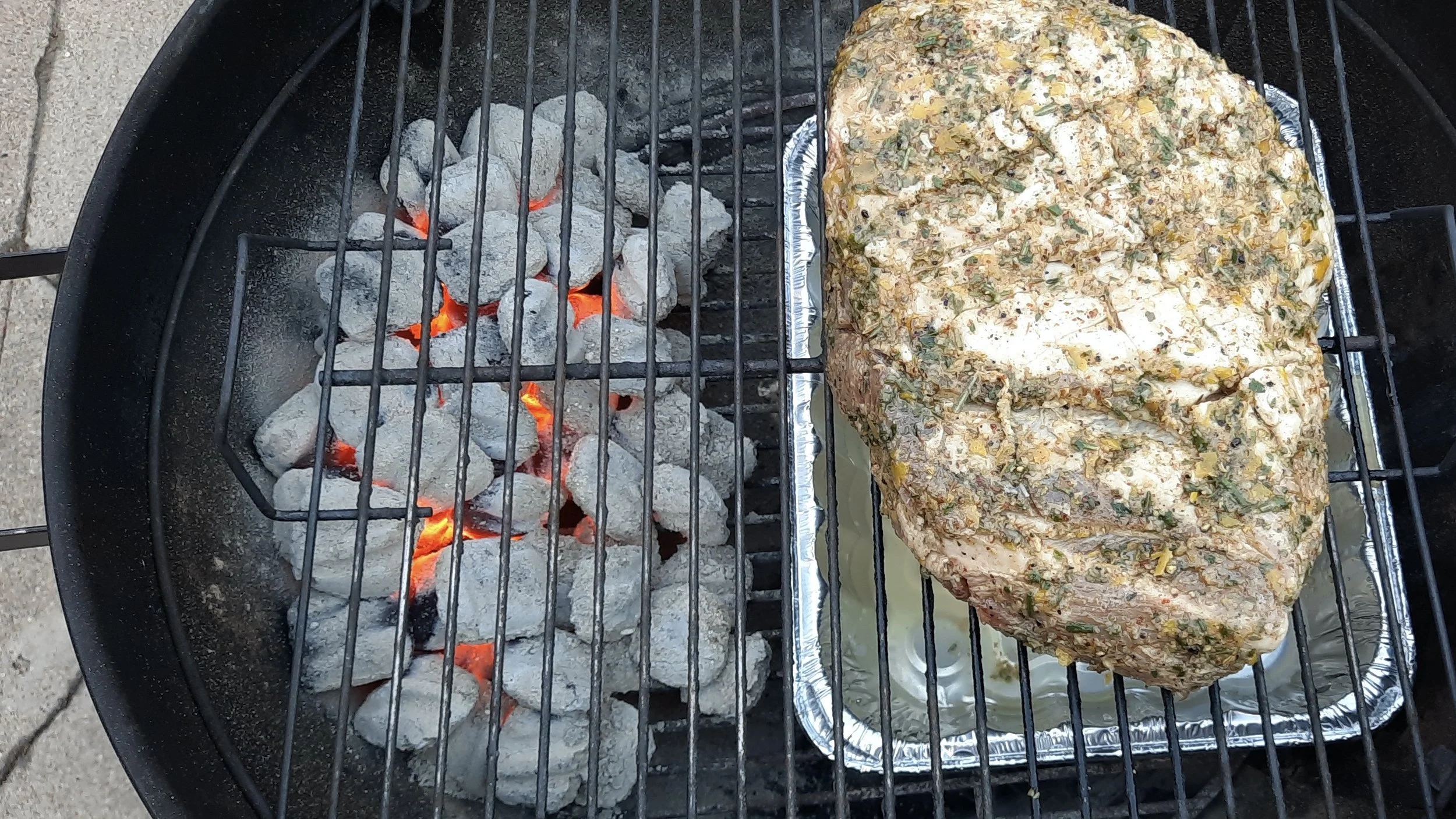GRILLED AND SMOKED PORK SHOULDER
After flavoring it overnight, grill the pork shoulder using the “indirect method” so that the heat is to one side of the grill. That allows for long, slow, smoky cooking.
It’s a butcher’s or cook’s axiom that more flavorful meat comes from the animal’s tougher, more muscle-bound and sinew-riven cuts.
Such is the case with pork shoulder, an inexpensive part of the pig due to its varied musculature, ample fat and copious connective tissue. But therein lies its deliciousness: with long, slow cooking, especially over coals or outdoor flame, all those “negatives” melt into positives.
That fat and collagen baste the meat as it cooks over several hours, both moistening the whole, as well as gelatinizing into awesomeness. With a generous and proper flavoring ahead of time, a slab of swine that costs $2-$3 a pound ends up worth much more to tastes of the tongue.
Here are two “marinades” or wet rubs for a pork shoulder destined to be cooked on an outside grill, heated either by coal or gas. I devised the Mediterranean seasoning to capture the aromas and flavors of both the sea’s northern rim of southern France and Italy (the herbs and garlic especially), as well as its southern side along the coast of northern Africa (the lemon and all those succulent seeds).
In addition, I include a wet rub heady with chiles, in the Central and North American way.
Grilled Pork Shoulder with Mediterranean Seasonings
Serves 6-8.
Ingredients
1 6-7 pound bone-in pork shoulder with fat cap
1 teaspoon black peppercorns
1/2 teaspoon cumin seeds
1/2 teaspoon coriander seeds
1/2 teaspoon fennel seeds
1/2 teaspoon fennel pollen (optional)
1 teaspoon red pepper flakes (Urfa or Aleppo preferred)
1 teaspoon fresh thyme leaves
1 teaspoon fresh sage leaves
1/2 teaspoon fresh rosemary needles
1/2 teaspoon dried Mediterranean oregano
Zest or peel from 1 lemon
8 cloves garlic, peeled and chopped
Juice from 1 lemon
1/4 cup extra virgin olive oil
1 tablespoon salt
Directions
Using a mortar and pestle or molcajete, roughly break up the peppercorns. Add the cumin, coriander and fennel seeds and continue grinding them, but merely roughly. Add the fennel pollen, if using, and the red pepper flakes and grind up a bit. Set aside.
Very finely mince or use a mini-processor to blend together the thyme and sage leaves, the rosemary needles, oregano, the lemon zest or peel and the garlic. In a bowl (or continuing with the mini-processor), add the ground-up spices and seeds, the lemon juice and the olive oil and salt. Make of everything a thick and well-blended paste.
Rinse off the pork shoulder and lay it fat-side down and trim off any large, extraneous globs of fat or sinew. Turn it fat-side up and make a crosshatch pattern of 1-inch squares into the fat (but not cutting down into any meat or muscle). Using a paring knife, make a dozen or more deep slits into the meat, all around the shoulder.
Slather the flavoring paste all over the pork, on both sides, pushing some of the paste into the slits made with the knife and being sure to get some of the paste into the crosshatch cuts. Place the shoulder, fat-side up, on a non-reactive sheet pan or tray, cover tightly with plastic wrap and place in the refrigerator overnight.
When ready to cook, remove the pork from the refrigerator and allow it to come to room temperature (1 hour or so). Prepare a grill that has a cover and that allows for both direct as well as indirect cooking (coals or flame to one side).
Place a disposable aluminum tray next to the coals, if using charcoal, and pour into it 3 cups of water (or low-sodium chicken broth). Replace the grate and place the pork, skin-side up, on the grate over the tray.
Place an oven thermometer on the cool side of the grate, close up the grill, keeping all vents open, and slowly cook the pork, skin-side up for nearly the entire time, maintaining a temperature of 250 degrees. (You well may need to add a few pieces of charcoal every hour or so in order to maintain the heat. Do not allow any coals to find themselves directly under the pork. If you wish, flip the pork around a couple of times.)
When the thickest part of the pork, not touching the bone, reaches an internal temperature of 190 degrees, remove the pork and keep it warm under a foil tent. Allow it to sit for 1 hour before shredding it with two forks or protected hands.
Grilled Pork Shoulder with Red Chile Paste: For all the flavorings above, substitute a paste made in a processor of 2 tablespoons each kosher or sea salt; freshly ground black pepper; 6 each seeded, stemmed and rehydrated guajillo and arbol peppers; 6 fresh seeded and de-veined Fresno peppers; 10 cloves peeled garlic, 1/2 peeled, chunked white onion, 1 bunch cilantro, 2 inches cut off the lower stems and 6 tablespoons apple cider vinegar. Proceed with all else in the recipe.
